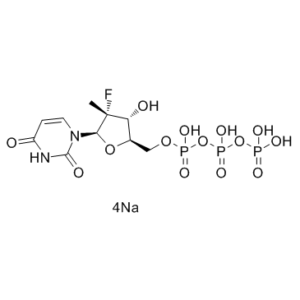This product is for research use only, not for human use. We do not sell to patients.

| Size | Price | Stock |
|---|---|---|
| 100mg | $3250 | To Be Confirmed |
| 200mg | $4875 | To Be Confirmed |
| 500mg | $8225 | To Be Confirmed |
Cat #: V3613 CAS #: 1621884-22-7 Purity ≥ 98%
Description: PSI-7409 tetrasodium is a novel and active 5'-triphosphate metabolite of Sofosbuvir (PSI-7977). Sofosbuvir (also known as PSI-7977, GS-7977; trade names Sovaldi and Virunon) is a HCV NS5B polymerase inhibitor that is used for the treatment of chronic hepatitis C virus (HCV) infection. Sofosbuvir acts by inhibiting the RNA polymerase that the hepatitis C virus uses to replicate its RNA. It is a component of the first all-oral, interferon-free regimen approved for treating chronic Hepatitis C. In 2013, the FDA approved sofosbuvir in combination with ribavirin (RBV) for oral dual therapy of HCV genotypes 2 and 3, and for triple therapy with injected pegylated interferon (pegIFN) and RBV for treatment-naive patients with HCV genotypes 1 and 4.
Publications Citing InvivoChem Products
Product Promise

- Physicochemical and Storage Information
- Protocol
- Related Biological Data
- Stock Solution Preparation
- Quality Control Documentation
| Molecular Weight (MW) | 592.12 |
|---|---|
| Molecular Formula | C₁₀H₁₆FN₂Na₄O₁₄P₃ |
| CAS No. | 1621884-22-7 |
| Storage | -20℃ for 3 years in powder formr |
| -80℃ for 2 years in solvent | |
| Solubility In Vitro | DMSO: N/Ar |
| Water: >100 mg/mr | |
| Ethanol: N/A | |
| SMILES Code | O[C@@H]([C@@](C)(F)[C@H](N1C(NC(C=C1)=O)=O)O2)[C@H]2COP(O)(OP(OP(O)(O)=O)(O)=O)=O.[4Na] |
| Synonyms | PSI-7409 tetrasodium; PSI 7409 tetrasodium; PSI7409 tetrasodium. |
| Protocol | In Vitro | PSI-7409 tetrasodium is an active 5'-triphosphate metabolite, inhibiting HCV NS5B polymerases, with IC50s of 1.6, 2.8, 0.7 and 2.6 μM for GT 1b_Con1, GT 2a_JFH1, GT 3a, and GT 4a NS5B polymerases, respectively. PSI-7409 also weakly inhibits human DNA polymerase α, with an IC50 of 550 μM, but shows no inhibition on DNA Pol β and γ. In clone A cells, the levels of PSI-7409 gradually increases to a maximum concentration of about 25 μM over a period of 48 h. PSI-7409 forms at a much faster rate in primary human hepatocytes, achieving a maximum intracellular concentration of ∼100 μM at 4 h and remains at that concentration for 48 h. |
|---|
| Solvent volume to be added | Mass (the weight of a compound) | |||
|---|---|---|---|---|
| Mother liquor concentration | 1mg | 5mg | 10mg | 20mg |
| 1mM | 1.6888 mL | 8.4442 mL | 16.8885 mL | 33.7769 mL |
| 5mM | 0.3378 mL | 1.6888 mL | 3.3777 mL | 6.7554 mL |
| 10mM | 0.1689 mL | 0.8444 mL | 1.6888 mL | 3.3777 mL |
| 20mM | 0.0844 mL | 0.4222 mL | 0.8444 mL | 1.6888 mL |
This equation is commonly abbreviated as: C1 V1 = C2 V2
- (1) Please be sure that the solution is clear before the addition of next solvent. Dissolution methods like vortex, ultrasound or warming and heat may be used to aid dissolving.
- (2) Be sure to add the solvent(s) in order.




































